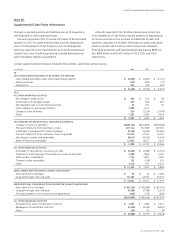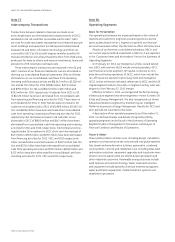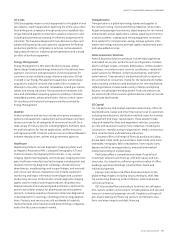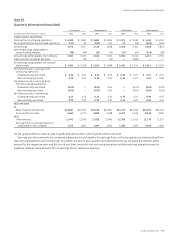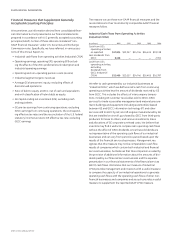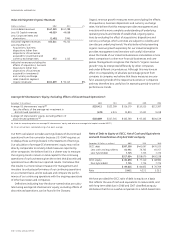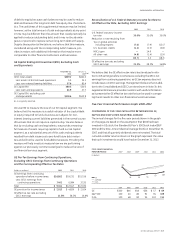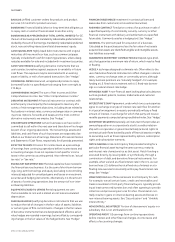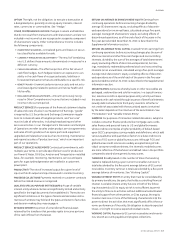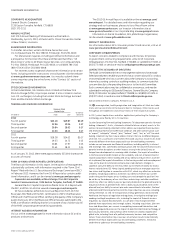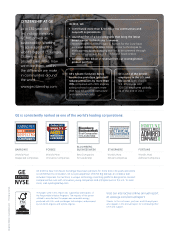GE 2012 Annual Report Download - page 147
Download and view the complete annual report
Please find page 147 of the 2012 GE annual report below. You can navigate through the pages in the report by either clicking on the pages listed below, or by using the keyword search tool below to find specific information within the annual report. GE 2012 ANNUAL REPORT 145
OPTION The right, not the obligation, to execute a transaction at
a designated price, generally involving equity interests, interest
rates, currencies or commodities. See “Hedge.”
OTHER COMPREHENSIVE INCOME Changes in assets and liabilities
that do not result from transactions with shareowners and are not
included in net income but are recognized in a separate component
of shareowners’ equity. Other Comprehensive Income includes
the following components:
Þ INVESTMENT SECURITIES— Unrealized gains and losses on securi-
ties classified as available-for-sale.
Þ CURRENCY TRANSLATION ADJUSTMENTS— The result of translating
into U.S. dollars those amounts denominated or measured in a
different currency.
Þ CASH FLOW HEDGES— The effective portion of the fair value of
cash flow hedges. Such hedges relate to an exposure to vari-
ability in the cash flows of recognized assets, liabilities or
forecasted transactions that are attributable to a specific risk.
Þ BENEFIT PLANS— Unamortized prior service costs and net actu-
arial losses (gains) related to pension and retiree health and
life benefits.
Þ RECLASSIFICATION ADJUSTMENTS— Amounts previously recog-
nized in Other Comprehensive Income that are included in net
income in the current period.
PRODUCT SERVICES For purposes of the financial statement display
of sales and costs of sales in our Statement of Earnings, “goods”
is required by U.S. Securities and Exchange Commission regula-
tions to include all sales of tangible products, and “services”
must include all other sales, including broadcasting and other
services activities. In our Management’s Discussion and Analysis
of Operations we refer to sales under product service agreements
and sales of both goods (such as spare parts and equipment
upgrades) and related services (such as monitoring, maintenance
and repairs) as sales of “product services,” which is an important
part of our operations.
PRODUCT SERVICES AGREEMENTS Contractual commitments, with
multiple-year terms, to provide specified services for products in
our Power & Water, Oil & Gas, Aviation and Transportation installed
base—for example, monitoring, maintenance, service and spare
parts for a gas turbine/generator set installed in a customer’s
power plant.
PRODUCTIVITY The rate of increased output for a given level of
input, with both output and input measured in constant currency.
PROGRESS COLLECTIONS Payments received on customer contracts
before the related revenue is recognized.
QUALIFIED SPECIAL PURPOSE ENTITIES (QSPEs) A type of variable
interest entity whose activities are significantly limited and entirely
specified in the legal documents that established it. There also are
significant limitations on the types of assets and derivative instru-
ments such entities may hold and the types and extent of activities
and decision-making they may engage in.
RETAINED INTEREST A portion of a transferred financial asset
retained by the transferor that provides rights to receive portions
of the cash inflows from that asset.
RETURN ON AVERAGE GE SHAREOWNERS’ EQUITY Earnings from
continuing operations before accounting changes divided by
average GE shareowners’ equity, excluding effects of discontin-
ued operations (on an annual basis, calculated using a five-point
average). Average GE shareowners’ equity, excluding effects of
discontinued operations, as of the end of each of the years in the
five-year period ended December 31, 2012, is described in the
Supplemental Information section.
RETURN ON AVERAGE TOTAL CAPITAL invested For GE, earnings from
continuing operations before accounting changes plus the sum of
after-tax interest and other financial charges and noncontrolling
interests, divided by the sum of the averages of total shareowners’
equity (excluding effects of discontinued operations), borrow-
ings, mandatorily redeemable preferred stock and noncontrolling
interests (on an annual basis, calculated using a five-point average).
Average total shareowners’ equity, excluding effects of discontin-
ued operations as of the end of each of the years in the five-year
period ended December 31, 2012, is described in the Supplemental
Information section.
SECURITIZATION A process whereby loans or other receivables are
packaged, underwritten and sold to investors. In a typical transac-
tion, assets are sold to a special purpose entity, which purchases
the assets with cash raised through issuance of beneficial interests
(usually debt instruments) to third-party investors. Whether or
not credit risk associated with the securitized assets is retained
by the seller depends on the structure of the securitization. See
“Monetization” and “Variable Interest Entity.”
SUBPRIME For purposes of Consumer-related discussion, subprime
includes consumer finance products like mortgage, auto, cards,
sales finance and personal loans to U.S. and global borrowers
whose credit score implies a higher probability of default based
upon GECC’s proprietary scoring models and definitions, which add
various qualitative and quantitative factors to a base credit score
such as a FICO score or global bureau score. Although FICO and
global bureau credit scores are a widely accepted rating of indi-
vidual consumer creditworthiness, the internally modeled scores
are more reflective of the behavior and default risks in the portfolio
compared to stand-alone generic bureau scores.
TURNOVER Broadly based on the number of times that working
capital is replaced during a year. Current receivables turnover is
total sales divided by the five-point average balance of GE current
receivables. Inventory turnover is total sales divided by a five-point
average balance of inventories. See “Working Capital.”
VARIABLE INTEREST ENTITY An entity that must be consolidated by
its primary beneficiary, the party that holds a controlling financial
interest. A variable interest entity has one or both of the follow-
ing characteristics: (1) its equity at risk is not sufficient to permit
the entity to finance its activities without additional subordinated
financial support from other parties, or (2) as a group, the equity
investors lack one or more of the following characteristics: (a) the
power to direct the activities that most significantly affect the eco-
nomic performance of the entity, (b) obligation to absorb expected
losses, or (c) right to receive expected residual returns.
WORKING CAPITAL Represents GE current receivables and invento-
ries, less GE accounts payable and progress collections.
glossar


